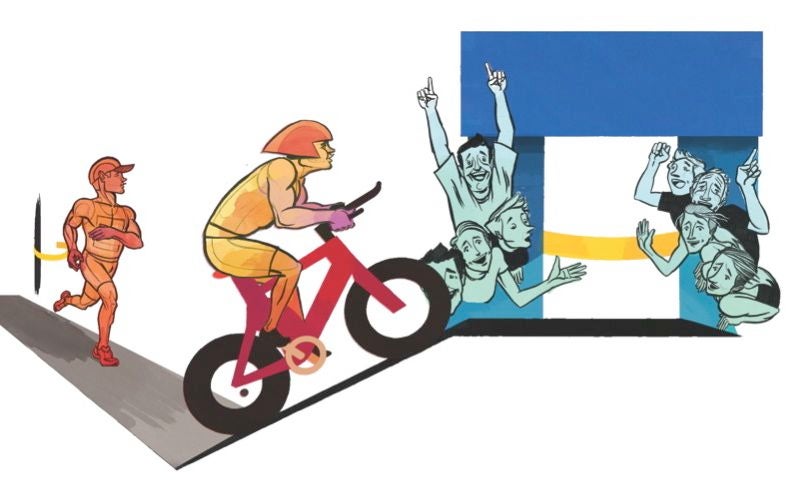8 Tips For Training Through A Race

Illustration by Hunter King.
Two days before a “B” race last season, I’d planned to do a fairly long, flat bike ride. Instead, a friend invited me to join him for a considerably longer and hillier adventure. Two days later I toed the line feeling about 90 percent fresh, raced as hard and smart as I could and finished third in my age group, about 60 seconds from the win. I was tempted to second-guess my long ride less than 48 hours earlier, but within a couple of weeks I was noticeably stronger and faster on both the bike and run, and satisfied with my decision to “train through” that lower-priority race. I was happy to have exchanged a couple of steps on the podium for an overall higher quality training week that has continued to pay dividends.
You may have heard the term “training through” before, perhaps as an excuse for an otherwise lackluster performance. But it does not always need to be viewed negatively. When done properly, it can be a valuable training tool for measurable fitness gains.
Top coaches advise you to limit yourself to no more than two or three “A” races per season. To do so, you follow a tailored training schedule that culminates with a distance-specific block, and then a one- to three-week taper. Following your peak performance, you’ll likely take at least a week or two to properly recover. That’s a lot of downtime without many quality workouts, but that’s what it takes to really peak and recover properly.
Fortunately for those who enjoy racing often, your local events calendars are chock full of super-fun, low-anxiety races. These are “B” and “C” races for which you don’t take much (if any) real taper and should treat as a well-structured hard workout with the added fun of a race environment. You still try really hard and plan to do your very best, understanding you may not be 100 percent recovered from recent workouts that were equally important to your long-term, higher priority goals. As such, you need to be OK with perhaps going a tad slower at full race effort, or seeing your name a few spots lower on the results sheet. Be confident in the strength and speed you are building by including such highly effective “training” sessions in the midst of a challenging fitness building block, and then plan to unleash your very best performance at your next well-planned “A” race.
RELATED: When Should I Taper Off Of Strength Training For My Race?
Key Tips
Spin to win. On race-week training rides, generate power using a higher cadence versus pushing harder on the pedals. While this is always a good plan for running well off the bike, it will likely aid in recovery, with less muscle soreness.
Eat and drink. Following key workouts during race week, refuel and rehydrate thoroughly to avoid starting the race depleted.
Focus on recovery. Use professional massage and self-massage as tools to help bounce back quickly from harder training sessions.
Schedule a race as a speed session. When your training calendar calls for a threshold or VO2max session, consider replacing it with a race for an even higher-quality workout.
Take extra warm-up. On race morning, plan to spend a little extra time warming up to liven up legs that are probably a bit stale from recent training.
Adjust goals. Most triathletes will race a touch slower without a proper taper, so adjust your attitude and aim to be satisfied with your effort, tactics and tenacity versus time or age-group placing.
Stick with sprints. The sprint distance is best for training through. Olympic distances are OK if you have a lot of experience. Half- and full Ironmans should be “A” races with a taper and full recovery.
Enjoy your fitness. Try to avoid putting all your eggs in one basket, whereby you avoid racing until your big “A” race at the end of the season. There are no guarantees it will go perfectly, so it can feel good to have had several small successes throughout the season.
Scott Fliegelman is the owner and head coach of FastForward Sports (Fastforwardsports.net) in Boulder, Colo.
RELATED: The Basics Of Triathlon Base Building
Follow Triathlete on Twitter @Triathletemag for inspiration, new workout ideas, gear reviews from our editors and more.